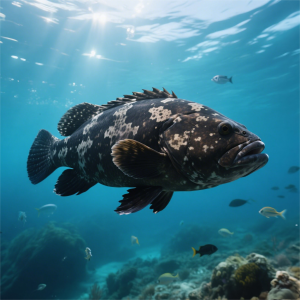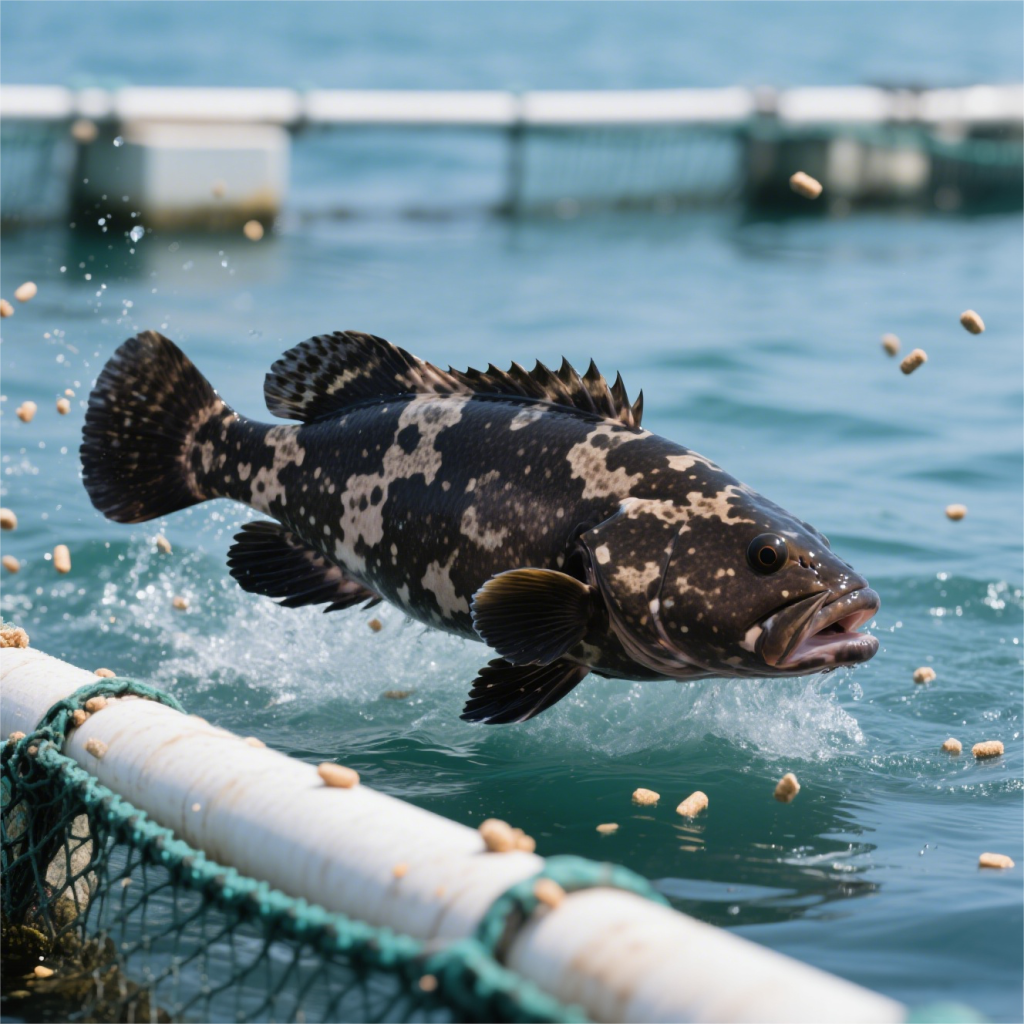Detailed Information on the Seedling Rearing and Cultivation Technology of the Black Grouper (Mycteroperca bonaci)

- Seedling Breeding
1.1 Reproduction Facilities
Indoor spawning pools have an area of 35 to 45 square meters and a water depth of 1.5 to 1.8 meters. Large or high-position (covered with plastic film) cement pools are preferably circular or octagonal, with an area of 100 to 1000 square meters.
Indoor industrialized seedling rearing pools are 20 to 30 square meters each, with a water depth of 1.2 to 1.5 meters, and are equipped with an independent water supply and drainage system. For outdoor large cement pool and high-position pool seedling rearing, the area of each pool is 100 to 200 square meters and 600 to 3000 square meters respectively, with a water depth of 1.5 to 2.5 meters. Both are equipped with heat preservation or sunshade facilities.
1.2 Selection of Parent Fish
Select adult fish with strong physique, no damage and deformity as the breeding parent fish. The source is mainly from the artificially cultured population, and individuals caught from nature should be supplemented in a timely manner.
1.3 Parent Fish Cultivation
It can be cultivated in sea cages, indoor/outdoor cement pools or high-position pools, with the density controlled below 3 kg per cubic meter. Three months before the breeding season, conduct nutritional enhancement. The daily feeding amount is about 5% of the body weight, and add nutritional supplements such as vitamins and fish liver oil.
1.4 Artificial Induced Spawning
During the breeding season, select female parent fish with a full and soft abdomen. Use hormones such as carp pituitary gland (PG), human chorionic gonadotropin (HCG), and luteinizing hormone-releasing hormone (LHRH – A2) for ripening treatment. According to the gonadal development of the parent fish, use the dry guide method for artificial insemination.
1.5 Collection and Pretreatment of Fertilized Eggs
After slightly stirring the fertilized eggs, let them stand for 5 to 8 minutes. Use an 80-mesh silk screen to scoop up the floating egg grains, rinse them with clean water, and directly transfer them to the seedling rearing pool for hatching.
1.6 Incubation Management
Incubation methods include incubation in cages and in barrels. The incubation density in cages is 150,000 to 200,000 eggs per cubic meter, and the density in barrels is 500,000 to 1,000,000 eggs per ton, both using micro-flow aeration. Incubation in the seedling rearing pool is also an option, with the density controlled at 25,000 to 30,000 eggs per cubic meter. The water temperature is 21 to 26°C, the salinity is 30 to 35, the dissolved oxygen is not less than 5 mg/L, and the incubation period is 18 to 36 hours.
1.7 Details of Seedling Cultivation
Environmental Conditions: The suitable water temperature is 23 to 30°C, and the optimal is 25 to 28°C; the salinity is 20 to 33, and the optimal is 23 to 28; the pH value is maintained at 8.0 to 8.3; the light intensity is controlled at 5000 lux. Set one air stone every 2 square meters in the seedling rearing pool, and continuously aerate to keep the dissolved oxygen above 5 mg/L. The gas volume should be small and uniform in the initial stage and gradually increase as the fry grow.
Density Management: When the fry length is 20 to 30 mm, the density is 3000 to 5000 fry per square meter; when it is 30 to 40 mm, it is reduced to 2000 to 3000 fry per square meter; when it is 40 to 50 mm, it is further reduced to 1000 to 1500 fry per square meter; when the total length exceeds 100 mm, the density is adjusted to 200 to 400 fry per square meter.
Water Quality Regulation Strategy: Starting from the 3rd day after hatching, change the water once a day, with a water change rate of 20% to 30%, and suck out the dirt once every other day. After the 20th day, feed the nauplii of Artemia salina, and increase the water change rate to 50%, suck out the dirt and change the water every day. From the 40th day, start feeding copepods, and increase the water change rate to 60% to 100%. After sucking out the dirt, change 50% of the water first, and the remaining part is in a flowing water mode. After feeding the compound feed, the water change rate reaches 100% to 200%. After each feeding, suck out the dirt and change 50% of the water. Adjust the flowing water volume according to the water quality situation to ensure that the water temperature difference during the water change does not exceed ±1°C.
Taming Management: Newly hatched fry need to be artificially tamed to adapt to the compound feed. Gradually increase their acceptance of the compound feed by frequent feeding, and still need to be supplemented with biological baits such as large Artemia salina and copepods during this period. Taming can be carried out in a small cage or water tank. After the fry are completely adapted to the compound feed, reduce the feeding frequency.
Pool Division and Harvesting: As the seedlings grow, carry out pool division management in a timely manner. When the total length of the juvenile fish reaches or exceeds 100 mm, they can be prepared for harvesting. Stop feeding one day before harvesting, lower the water level to 0.5 to 0.6 meters, and use an 8 to 10-mesh nylon silk screen to pull the net to gather the seedlings, and fish them out with water.
- Adult Fish Cultivation
2.1 Cage Culture
Cultivation Environment: Select a well-sheltered harbor, with a gentle seabed terrain and a small slope. The bottom sediment is muddy or sandy-muddy, and the water depth is more than 15 meters. There are no industrial “three wastes” and agricultural, domestic and other pollution sources around the cultivation area. The water temperature is 18 to 30°C, the salinity is 25 to 32, the pH value is 7.8 to 8.5, and the transparency is more than 3.0 meters.
Facilities and Equipment: The general specifications of the cages are 3m×3m×4m, 4m×4m×4m, 6m×6m×5m, etc., with a depth of more than 6 meters. Each fish raft is composed of multiple cages. There should be sub-channels, secondary channels and main channels between each fish raft, and the direction of the main channel is parallel to the tidal current. After continuous cultivation in the cage cultivation area for 3 years, it is advisable to rest for more than 1 year.
Stocking of Fingerlings: Select fingerlings with uniform specifications, bright body color, no ulceration on the body surface, no deformity, sensitive response and schooling behavior, and that have passed the quarantine inspection for stocking. A small amount of bream family fish of the same individual size such as Pagrosomus major, Sparus macrocephalus, and Acanthopagrus latus, as well as Siganus spp., can be mixed cultured, and the mixed culture proportion is about 15%. For fingerlings with a specification of 50 g per tail, the stocking density of 80 to 100 tails per cubic meter is appropriate. As the fingerling specification increases, the stocking density is reduced. When the specification reaches 500 g per tail, the stocking density of 10 to 20 tails per cubic meter is appropriate.
Cultivation Management: Select compound feed with a suitable particle size according to the size of the fish for feeding. The feed coefficient is between 1.0 and 1.5, and it is sufficient to feed 1 to 2 times a day.
2.2 Pond Culture
Pond Conditions: The bottom sediment of the pond is preferably sandy or semi-sandy, and hard mud bottom is also acceptable; the surrounding sea area has no water pollution and high transparency; the area of the fish pond is preferably 5 to 10 mu, and the water depth is more than 1 meter.
Pond Cleaning and Placement of Artificial Reefs: After the fish pond is exposed to the sun and the sediment is removed, lay some broken stones at the bottom of the pond or place some perforated waste tires, tile water cylinders, etc., to meet the habit of the black grouper that likes to drill into holes.
Stocking of Fingerlings: The fingerlings for cultivation are required to be energetic, disease-free, and with a body color biased towards black, and they should be sorted by size. The stocking density varies according to local conditions. Generally, for fingerlings with a specification of about 100 g per tail, about 0.5 tail can be stocked per square meter.
Feeding Management: The bait is mainly fresh small trash fish, and live bait is the best. Cut it into pieces of appropriate size according to the specification of the fingerlings for feeding. When feeding, adopt a fixed quantity feeding method. Generally, it accounts for 10% to 15% of the fish body weight in the early stage and 5% to 10% in the later stage. The best feeding times are from 5 to 6 in the morning and from 7 to 8 in the evening. In daily management, the water temperature is required to be 14 to 30°C, the salinity is 12 to 35‰, the pH value is 7.8 to 8.4, the dissolved oxygen is more than 4 mg/L, and the daily water exchange amount generally requires 1/3 to 1/4.
- Disease Prevention and Control
The black grouper is prone to various viral, bacterial and parasitic diseases, such as nervous necrosis virus disease, white spot disease, gill cleft disease, etc. The preventive measures mainly include regular detection of water quality, timely adjustment and treatment; maintaining the cleanliness of the cultivation environment and regularly disinfecting the cultivation facilities; strengthening the prevention and control of epidemic diseases to avoid the occurrence and spread of diseases; reasonably controlling the cultivation density to avoid overcrowding; strengthening the immunization work to improve the resistance of the fish. For common diseases, drug treatment should be carried out in a timely manner, but pay attention to the dosage and method of drug use to avoid the harm of drug residues to the fish body and the environment.
